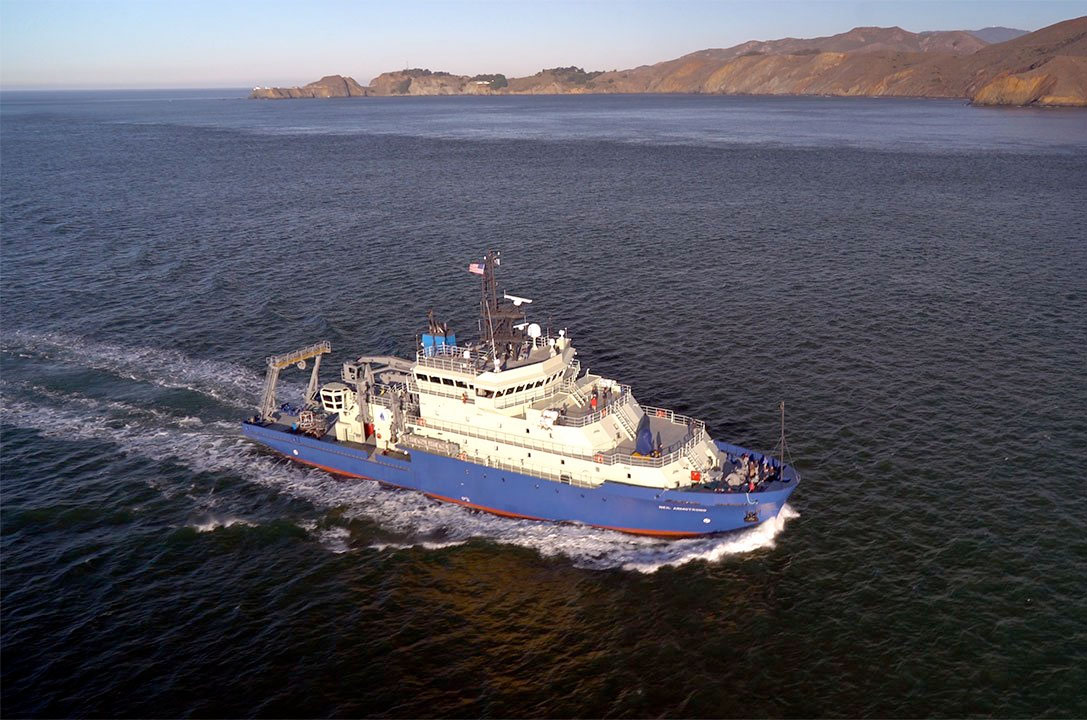R/V Neil Armstrong Arrives at Woods Hole Oceanographic Institution

The world's largest nonprofit organization dedicated to studying marine science and engineering took a giant leap forward on Wednesday (April 6), welcoming its new research vessel, the R/V Neil Armstrong, to its port in Woods Hole, Massachusetts.
The 238-foot-long (72.5 meters) ship, which was named in 2014 for the first man to walk on the moon, arrived at the Woods Hole Oceanographic Institution (WHOI), where it was met by an audience of invited guests that included members of Armstrong's family and an International Space Station (ISS) commander.
"Welcome to the Neil Armstrong," said Sunita Williams, a NASA astronaut and U.S. Navy Captain who flew twice to the ISS. "It's really great to see her here to start her new career." [Photos: Neil Armstrong - American Icon Remembered]
The R/V Neil Armstrong pulled into port just after 10 a.m. EDT (1400 GMT) on Wednesday to begin its decades-long mission of science and exploration. Capable of putting out to sea for as long as 40 days with 44 scientists and crew, the ship is equipped to conduct advanced ocean research almost anywhere in the world.
The first of the new Armstrong-class of research vessels, the R/V Neil Armstrong was launched on Feb. 20, 2014 in Anacortes, Washington. The ship underwent outfitting and trials prior to its delivery to Woods Hole on Wednesday.
Owned by the Navy, the R/V Neil Armstrong was provided to WHOI under a no-cost lease by the government.
"Since Neil Armstrong [the astronaut] landed on the moon almost 50 years ago, there have been only nine ships built and added to the academic research fleet," said Williams. "Neil Armstrong will be one of just seven large vessels of the nation's research fleet."
Breaking space news, the latest updates on rocket launches, skywatching events and more!
The Neil Armstrong replaces the R/V Knorr, best known for supporting the researchers who discovered the wreck of the RMS Titanic in 1985. That ship was named for Ernest Knorr, a leader of the Navy's first systematic charting and surveying effort from 1860 to 1885.
In service to WHOI for 44 years beginning in 1970, the R/V Knorr traveled the rough equivalent of two round trips from the Earth to the moon.
"Much like astronauts, we go out and explore new worlds," said Mark Abbott, the president and director of WHOI. "But we are doing more than just exploration. Our ships service whole new fleets of moorings, of gliders, robots and Earth-orbiting satellites."
"And ships like the Neil Armstrong and her sister ship, the [R/V] Sally Ride, are essential to take us to these places and deploy and service these fleets of instruments. They will serve us for the next 50 years. They are the technically most capable ships in the fleet today," said Abbott.
The R/V Neil Armstrong is outfitted with a modern suite of oceanographic equipment, including acoustics capable of mapping the deepest oceans and advanced over-the-side handling gear to deploy and retrieve scientific instruments.
"With the discovery and evidence of water on Mars, I think all of us are now becoming acutely aware that if we want to sustain life on Earth, we need a greater understanding of the oceans' vital impacts on the Earth's climate and life," said Williams. "Luckily for us, in the next half a century, the R/V Neil Armstrong will take generations of researchers to remote ocean frontiers."
In addition to the Ride and Armstrong, the Navy has four other ships named after U.S. astronauts. The USNS Alan Shepard, named for the first American to fly in space, was launched in 2006; the USNS Wally Schirra, named after the only pilot to fly Mercury, Gemini and Apollo capsules, was launched in 2009; and the USNS John Glenn, named for the first American to orbit Earth, was named in 2014.
The R/V Neil Armstrong was christened in the memory of the Apollo moonwalker, who died in 2012 at the age of 82. Armstrong served at NASA as an engineer, research test pilot, astronaut and administrator. Prior to joining the space program, he flew combat missions during the Korean War as a naval aviator.
"I know Neil would love this because Neil was Navy," said Carol Armstrong, the astronaut's widow. "That is where he started and that is where his heart was."
Follow collectSPACE.com on Facebook and on Twitter at @collectSPACE. Copyright 2016 collectSPACE.com. All rights reserved.

Robert Pearlman is a space historian, journalist and the founder and editor of collectSPACE.com, a daily news publication and community devoted to space history with a particular focus on how and where space exploration intersects with pop culture. Pearlman is also a contributing writer for Space.com and co-author of "Space Stations: The Art, Science, and Reality of Working in Space” published by Smithsonian Books in 2018.
In 2009, he was inducted into the U.S. Space Camp Hall of Fame in Huntsville, Alabama. In 2021, he was honored by the American Astronautical Society with the Ordway Award for Sustained Excellence in Spaceflight History. In 2023, the National Space Club Florida Committee recognized Pearlman with the Kolcum News and Communications Award for excellence in telling the space story along the Space Coast and throughout the world.


